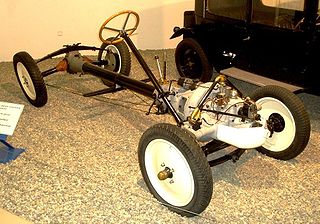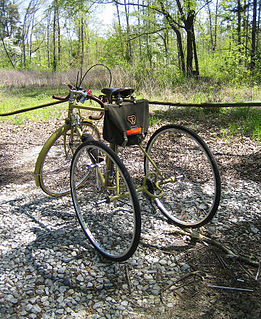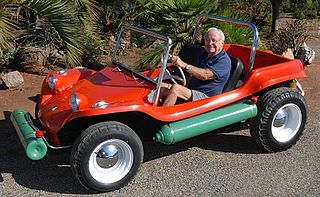
The Meyers Manx dune buggy is a small recreationally-oriented automobile, designed initially for desert racing by Californian engineer, artist, boat builder and surfer Bruce F. Meyers. It was produced by his Fountain Valley, California company, B. F. Meyers & Co. from 1964 to 1971, in the form of car kits applied to shortened chassis of Volkswagen Beetles. The car line dominated dune racing in its time, breaking records immediately, and was eventually also released in street-oriented models, until the company's demise due to tax problems after Meyers's departure. New vehicles inspired by the original Manx buggy have been produced by Meyers's re-founded operation, Meyers Manx, Inc., since 2000. The name and cat logo of the brand derives from the Manx cat, by virtue of the tailless breed's and the shortened vehicle's truncated "stubbiness".

The Volkswagen Type 181 is a two-wheel drive, four-door, convertible, manufactured and marketed by Volkswagen from 1968 to 1983. Originally developed for the West German Army, the Type 181 was also sold to the public, as the Kurierwagen in West Germany, the Trekker in the United Kingdom, the Thing in the United States (1973–74), the Safari in Mexico and South America, and Pescaccia in Italy. Civilian sales ended after model year 1980.

The Volkswagen Brasília is a rear-engined compact car, manufactured and marketed by Volkswagen in Brazil between 1973 and 1982; in Mexico from 1974-1982; and as knock down kits in Nigeria where it was marketed as the Igala from 1976-1980.

The Volkswagen Country Buggy is a small utility vehicle designed and built by Volkswagen in Australia and the Philippines. It used parts from the existing Type 1 and Type 2. Production ran from 1967 to 1968. A derivative of the Country Buggy called the Sakbayan was built in the Philippines for several years until 1980.
The Avenger GT was a kit car designed in California and manufactured in the United States and Canada, primarily in the 1960s and early 1970s. The car was manufactured by Fiberfab, a company founded by Warren "Bud" Goodwin and was the successor to the Fiberfab Aztec. The car was styled to resemble the Ford GT of racing fame in the 1960s, often referred to as the GT40. These Fiberfab creations were the first kit-cars available that followed the lines and styling of the GT40; thus, popularizing and developing the kit-car industry to new heights and starting the whole tribute / replicar GT40 industry that follows today.

The Volkswagen air-cooled engine is an air-cooled boxer engine with four horizontally opposed cast-iron cylinders, cast aluminum alloy cylinder heads and pistons, magnesium-alloy crankcase, and forged steel crankshaft and connecting rods.
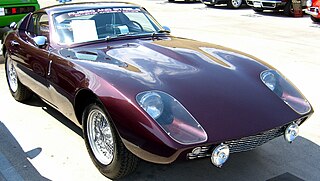
Fiberfab Velocidad Inc was an American kit car manufacturer founded by Warren "Bud" Goodwin in 1964.

Sterling Sports Cars was an American automobile company based in Wilmington, Delaware that designed and manufactured assembly kits for replicars and supercars.
Dax Cars is a British sports car manufacturer founded in 1968 and based in North Weald, Essex, England.

New Zealand had a long history of small garages and vehicle enthusiasts modifying and creating sports and sports racing cars. Out of these interests grew the New Zealand kit and replica car industry with the introduction of fibre-glass car bodies in the 1950s.
Brockmore Classic Replicas Limited was a British automotive manufacturer.
Carcraft Engineering was a British manufacturer of automobiles.

The Stimson Scorcher is a three-wheeled vehicle designed by Barry Stimson and first produced in the UK in 1976. The Scorcher was available preassembled or as a kit, sold by Noovoh Developments of Brighton for £385.

The Stimson Sting is a three-wheeled motor vehicle designed by Barry Stimson. Available as a kit car, it was introduced into the UK in 2002 and continued in production until 2007, although only one was built in that time. The Sting has two wheels at the front and two seats, along with a conventional car steering wheel.

The Stimson Storm is a three-wheeled motor vehicle designed by Barry Stimson, and offered for sale as a kit car. It was introduced into the UK in 2002 and continued in production until 2007, although only one was built during that time.

The Midas Bronze is a Mini-based kit car designed by Richard Oakes and manufactured by D&H Fibreglass Techniques, set up by Harold Dermott and Maurice Holt in 1975. Their initial production facility was in Oldham, England, but when they outgrew that they moved to larger premises in Corby.
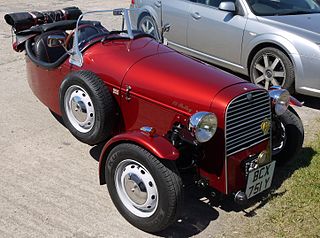
The DRK is a three-wheeled kit car produced by DRK Kits of Ellesmere Port, England, between 1987 and 1998. The car was introduced at the Cheshire Kit Car show in May 1986, where its positive reception prompted the formation of the company to build it.

Blackjack cars, founded by Richard Oakes in 1996, is a manufacturer of three-wheeled kit cars based in Helston, Cornwall, England. The company's first car, the Blackjack Avion, was produced from 1996 until 2004, replaced by the VW Beetle-engined Blackjack Zero. In 2008 a lighter variant of the Zero known as the Blackjack Guzzi was introduced, the name derived from the Moto Guzzi motorcycle engine that powers it.



